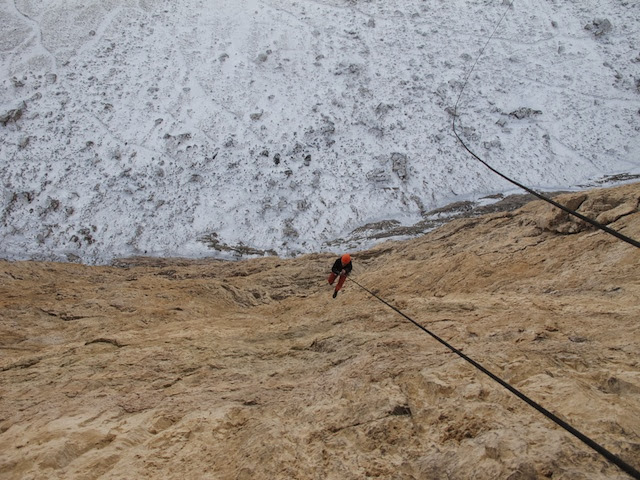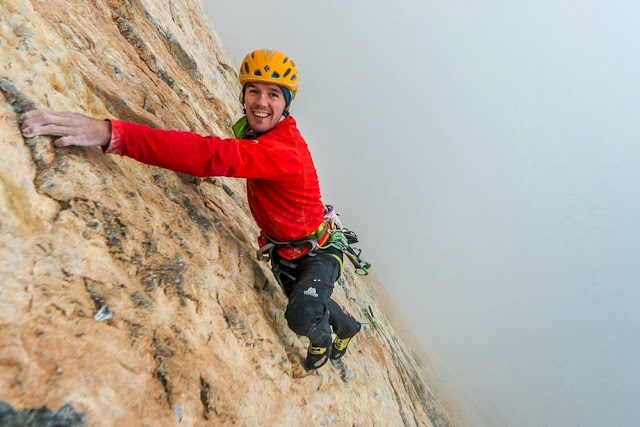Cold but happy climbers after Bellavista. Photo: Alan Cassidy (you should read his blog, it’s really good)
Before my ‘long shot’ trip to Bellavista with Alan Cassidy, I had a small hiccup. I was leading Hold Fast, Hold True (E9) in Glen Nevis a week before we were leaving and didn’t quite catch a hold right after the crux, slipping off and decking out from rather higher than one would like. I got away lightly, with quite nasty whiplash and a sprained left ankle. I was able to walk, well, between the kettle and the couch anyway. So I felt it wouldn’t be a problem for the upcoming trip.
I left it 5 days and then tried to get a couple of pre-trip training sessions in TCA before we left. To my dismay, I discovered that I couldn’t even nearly get a rockshoe on my fat, bruised foot. I had a session of one-footed traversing anyway and then went for an X-ray since things seemed to be getting more, not less painful. Sure enough, a couple of bone spurs that have restricted my left ankle dorsiflexion ever since I broke it in 1997 had broken off and are irritating my ankle joint. Some day surgery awaits. I’m quite looking forward to a couple of weeks of Beastmaker abuse during the Lochaber monsoon next month.
By the day we left for Cima Ovest, I’d managed to walk round Morrison’s, take Freida to toddler group and lie on my side in bed without taking Tramadol first. Things were looking up!
Alan trying to get the psyche to rock climb in winter climbing conditions
As I wrote in my last blog, we then proceeded to spend most of the trip being hammered by crap weather. The route was soaking, it rained, snowed, snowed a lot more and then got windy and freezing. We tried to climb on the 8c pitch anyway, but both of us knew we were getting absolutely nowhere. We became totally set in the viewpoint that having been soaking all week, the chances of it drying out a bit in our remaining three days were zilch.
Being practical, or venting wet weather frustration? You decide.
But it didn’t quite work out like that. On the third last day, I went out for a look on the 8c pitch first. The first half was still wet, but the second half was nearly dry, and I could link it to the belay straight away. Quite good. Alan went for his go and was also feeling like he could get to grips with the pitch a bit more. But then, as he was out of sight near the end of the pitch, I heard an “AAAAAGGHHH!”. The rope jerked momentarily tight, then suddenly slack again. Another loud scream and Alan appeared into view, dropping through space. He stopped, dangling at least 15 metres down in the void, with quickdraws sporting ripped pegs spinning down the rope towards him.
He was just sitting on a peg, brushing another damp hold when it ripped and the previous one ripped too. It must have been an exciting journey into space! After having a good laugh about Alan’s trip, we had a think about where this left us. There was now a big section near the end of the pitch with no gear in it. We were on budget flight mode and hadn’t been able to bring any pegs or aid gear in case we needed to re-equip.
In the end, we managed to borrow a hammer from the lovely folk at Rifugio Auronzo and I set up a tension traverse to back-aid and free climb back along from the next belay to the bit that needed re-equipping. I managed to get a sketchy cam in a pocket and gingerly sat on it and proceeded to fail to get the two ill fitting pegs to go in somewhere other than where they’d been before. After an hour, I had it sorted and the route was back online.
However, we had one day left. I just wanted to get the gear back and get home. Everything was wrong and I felt a bit fed up to be honest. My ankle hurt on the walk-in, I couldn’t do certain movements with it on the rock, I’d had my fill of climbing wet rock or frozen rock, we’d not had even one good day to try it properly. Worst of all, it was baltic.

Shall we go climb an 8c north face route today?
We’d not seen a single other party climbing on the north faces all trip. I’m not surprised. On the last day we wandered up, both of us ready to strip it and get on our plane home. Alan climbed the first three pitches (7b, 6c+, 6a+) in one big pitch again. He was clearly struggling to get any feeling from fingers and toes. It was well below zero and blowing a bitter wind. Seconding him, I felt like a frozen robot, clawing up the rock with zero feedback from my digits. Leading the next two pitches (7a, 7a+) I still couldn’t even get my core warm despite climbing in my Arete jacket. However, by the time a freezing Alan joined me, the wind had dropped a bit and I was feeling more myself with the full belay jacket and trousers armoury on.
I went out along the start of the 8c and was most surprised to find a special scenario of feelings come over me that doesn’t happen every day. The pitch was the driest it had been all trip. First, there was the sudden rushing feeling of being confident flowing through the moves rather than constantly expecting to ‘ping’ off wet holds. ‘I can still climb!’ Second, the ‘last day’ go for broke mentality clicked into place. When all the preparation has gone so badly, what do you have left except to see what can happen if you just don’t care anymore and go for a good fight with the pitch? Finally, I knew I was going to have one link attempt, so I might as well get it over with as quickly as possible and get home to see my family.

Alan drying holds on one of the 'warm' days
So after the five minute warm up burn, I blasted off at full tilt, through the crux and onto the weird back-and-foot rest at the block above. I wasn’t that pumped. So get going! Up through the mono move and onto the big traverse. I was breathing hard but forearms were absorbing the hit so far. At the undercut move I decided to start really trying and grunted through. But I was able to rest each hand on every hold. I got down to the move before a rest at a huge ‘Hueco’ pocket. My sequence is to fling my feet up into the hole first, have a rest in the bat hang and then flip round and throw my whole arm into it. My ankle was so weak I couldn’t pull up on the toehooks and nearly fell off. I took a few seconds more to figure out what to do, before resting my left foot once and then trying again. It worked and I hung from the arm-bar for five minutes, breathing slowly calming down. The final ten metres was a pure exercise in relaxation. I knew I could get to the belay if I didn’t make a mistake. The only way I’d make a mistake would be if I started to anticipate success. So I just switched off and pneumatic-ed through the holds with no emotion until the belay suddenly appeared in front of me.
Switching off completely means that when you do wake up and realise it’s done, it’s quite a shocker and the emotion comes flooding back. Alan wasted no time in gathering every down garment we had assembled at the belay and jugged up to join me, already shivering. I thawed out a little in the duvet while Alan cruised the 8a pitch above. I still had to jug up the rope and be lowered back down to do it myself, just to get the blood moving. The wind just kept cutting through me and in the next two pitches (6c+, 7a) I got really pumped on what should be easy ground. There just seemed to be no blood going through my forearms. We both had to second the remaining pitches to the Cassin ledge in the big jackets and duvet trousers! Never done that before, even in mixed climbing. There was just time to strip our gear out of the roof as it was getting dark and made it down to the base to find everything was frozen solid. We packed, rushed back to the car, then Venice for three hours sleep before boarding our flights back to Scotland.
It was really interesting for me to share the experience with Alan, who hasn’t done a great deal of mountain big wall climbs. Failing when the route is hard is something most climbers can deal with pretty well - why else do we try such hard climbs except to feel pushed and feel uncertainty? But failing through not being able to properly try can get under your skin. I certainly still find that creates a lot of restlessness in me. Last week I channelled it into finishing a draft of my book while the blizzards raged outside. Alan took it all really well and was able to keep turning on 'mission mode' all the way on the last day redpoint, despite the scary fall the previous day. His blogs through the week are a nice illumination of an adventure unfolding, the final twist coming right at the last hours before the flight home.
Even now I can’t believe that came together.












































